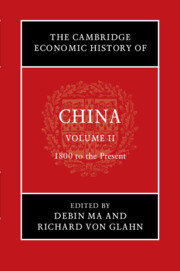Book contents
- The Cambridge Economic History of China
- The Cambridge Economic History of China
- The Cambridge Economic History of China
- Copyright page
- Contents
- Figures
- Maps
- Tables
- Contributors to Volume II
- Acknowledgments
- Note on Citations
- Introduction to Volume II
- Part I 1800–1950
- 1 Ideology and the Contours of Economic Change
- 2 Economic Transition in the Nineteenth Century
- 3 Agriculture
- 4 Handicraft and Modern Industries
- 5 The State and Enterprises in Late Qing China
- 6 State Enterprises during the First Half of the Twentieth Century
- 7 Money and the Macro-economy
- 8 Public Finance
- 9 Financial Institutions and Financial Markets
- 10 Chinese Business Organization
- 11 The Economic Impact of the West
- 12 Foreign Trade and Investment
- 13 Transport and Communication Infrastructure
- 14 Education and Human Capital
- Part II 1950 to the Present
- Index
- References
8 - Public Finance
from Part I - 1800–1950
Published online by Cambridge University Press: 07 February 2022
- The Cambridge Economic History of China
- The Cambridge Economic History of China
- The Cambridge Economic History of China
- Copyright page
- Contents
- Figures
- Maps
- Tables
- Contributors to Volume II
- Acknowledgments
- Note on Citations
- Introduction to Volume II
- Part I 1800–1950
- 1 Ideology and the Contours of Economic Change
- 2 Economic Transition in the Nineteenth Century
- 3 Agriculture
- 4 Handicraft and Modern Industries
- 5 The State and Enterprises in Late Qing China
- 6 State Enterprises during the First Half of the Twentieth Century
- 7 Money and the Macro-economy
- 8 Public Finance
- 9 Financial Institutions and Financial Markets
- 10 Chinese Business Organization
- 11 The Economic Impact of the West
- 12 Foreign Trade and Investment
- 13 Transport and Communication Infrastructure
- 14 Education and Human Capital
- Part II 1950 to the Present
- Index
- References
Summary
At the turn of the nineteenth century, the Qing dynasty entered a phase of social and economic decline. By 1850, mounting crises had exploded in a devastating series of rebellions (best known for the Taiping Rebellion, 1850–1864). Until 1880, up to a quarter of the population had perished, although the numbers are debated. The civil wars revealed the bankruptcy of the dogma of fixed tax quotas that had governed China’s fiscal thought since the Ming dynasty (see the chapter by von Glahn and Lamouroux in Volume 1). New commercial taxes, most prominently foreign customs and lijin 釐金 (literally “one-thousandth”) trade tariffs, soon exceeded agricultural taxes and increased state revenue. Fiscal recovery was short-lived, however, as the double defeat in the First Sino-Japanese War (1894–1895) and the Boxer Rebellion (1900–1901) once again threw Qing finances into turmoil. Servicing the war loans and indemnities while simultaneously promoting costly “New Policy” (xinzheng 新政) reforms (1901–1911), the imperial government gradually lost control of the provinces and was unable to check the nationalist awakening of its citizenry. This led to the 1911 Revolution and, eventually, national disintegration during the warlord era.
Keywords
- Type
- Chapter
- Information
- The Cambridge Economic History of China , pp. 244 - 279Publisher: Cambridge University PressPrint publication year: 2022

